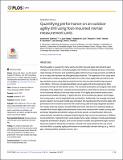Quantifying performance on an outdoor agility drill using foot-mounted inertial measurement units
Author(s)
Zaferiou, Antonia M.; Ojeda, Lauro; Cain, Stephen M.; Vitali, Rachel V.; Davidson, Steven P.; Perkins, Noel C.; Stirling, Leia A.; ... Show more Show less
Downloadjournal.pone.0188184.pdf (3.686Mb)
PUBLISHER_CC
Publisher with Creative Commons License
Creative Commons Attribution
Terms of use
Metadata
Show full item recordAbstract
This is an open access article distributed under the terms of the Creative Commons Attribution License, which permits unrestricted use, distribution, and reproduction in any medium, provided the original author and source are credited. Running agility is required for many sports and other physical tasks that demand rapid changes in body direction. Quantifying agility skill remains a challenge because measuring rapid changes of direction and quantifying agility skill from those measurements are difficult to do in ways that replicate real task/game play situations. The objectives of this study were to define and to measure agility performance for a (five-cone) agility drill used within a military obstacle course using data harvested from two foot-mounted inertial measurement units (IMUs). Thirty-two recreational athletes ran an agility drill while wearing two IMUs secured to the tops of their athletic shoes. The recorded acceleration and angular rates yield estimates of the trajectories, velocities and accelerations of both feet as well as an estimate of the horizontal velocity of the body mass center. Four agility performance metrics were proposed and studied including: 1) agility drill time, 2) horizontal body speed, 3) foot trajectory turning radius, and 4) tangential body acceleration. Additionally, the average horizontal ground reaction during each footfall was estimated. We hypothesized that shorter agility drill performance time would be observed with small turning radii and large tangential acceleration ranges and body speeds. Kruskal-Wallis and mean rank post-hoc statistical analyses revealed that shorter agility drill performance times were observed with smaller turning radii and larger tangential acceleration ranges an d body speeds, as hypothesized. Moreover, measurements revealed the strategies that distinguish high versus low performers. Relative to low performers, high performers used sharper turns, larger changes in body speed (larger tangential acceleration ranges), and shorter duration footfalls that generated larger horizontal ground reactions during the turn phases. Overall, this study advances the use of foot-mounted IMUs to quantify agility performance in contextually-relevant settings (e.g., field of play, training facilities, obstacle courses, etc.).
Date issued
2017-11Department
Massachusetts Institute of Technology. Department of Aeronautics and AstronauticsJournal
PLOS ONE
Publisher
Public Library of Science
Citation
Zaferiou, Antonia M. et al. “Quantifying Performance on an Outdoor Agility Drill Using Foot-Mounted Inertial Measurement Units.” edited by Yih-Kuen Jan. PLOS ONE 12, 11 (November 2017): e0188184 © 2017 Zaferiou et al.
Version: Final published version
ISSN
1932-6203